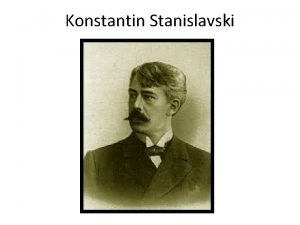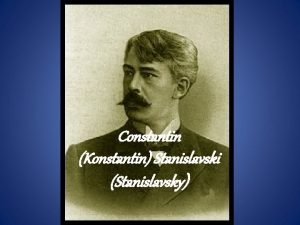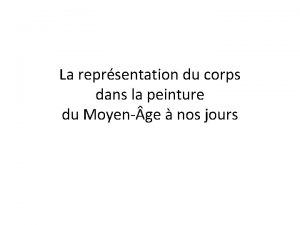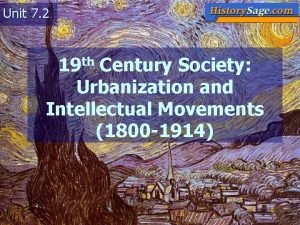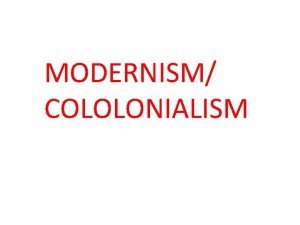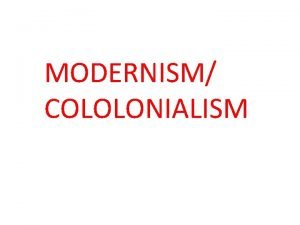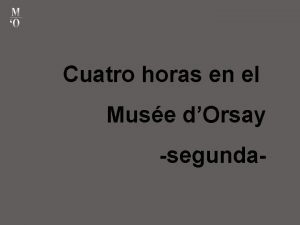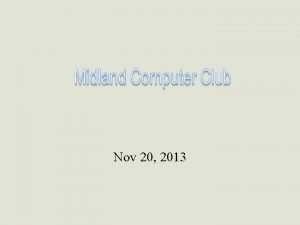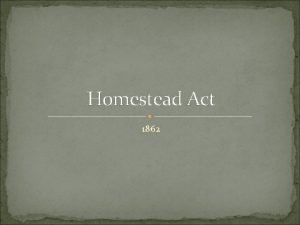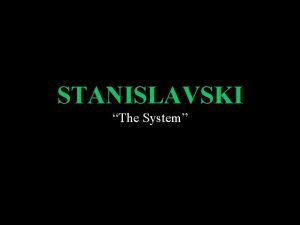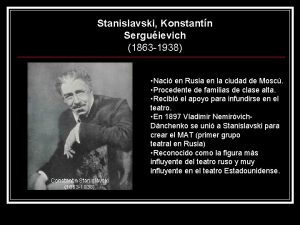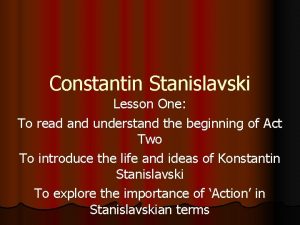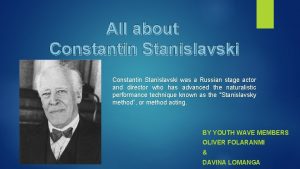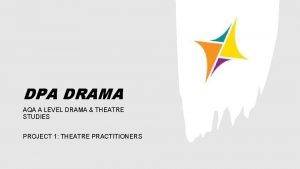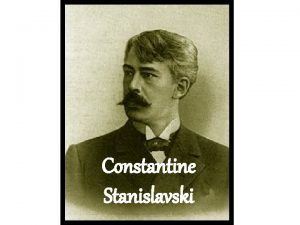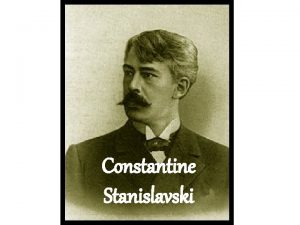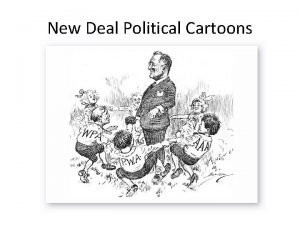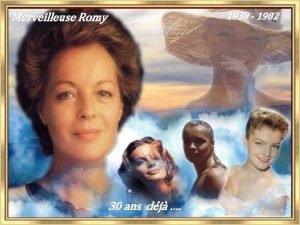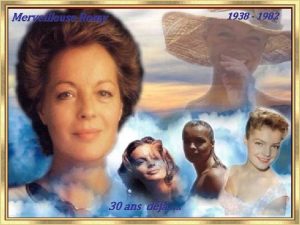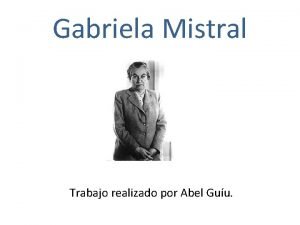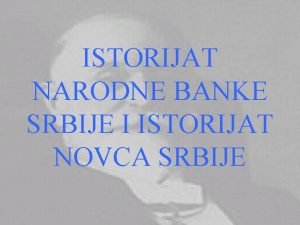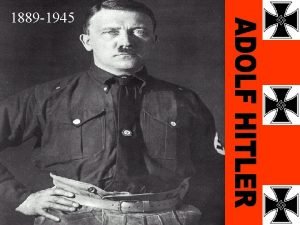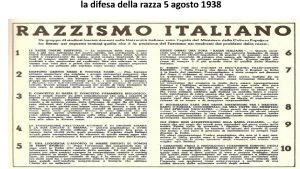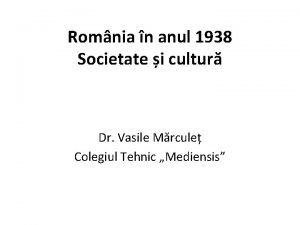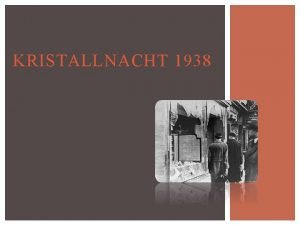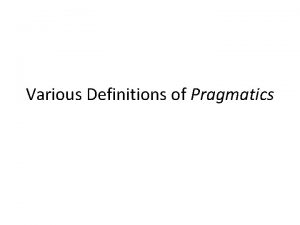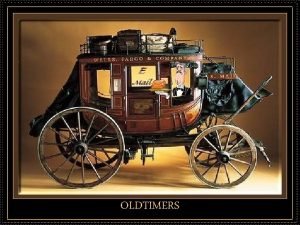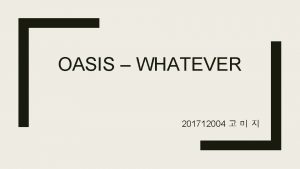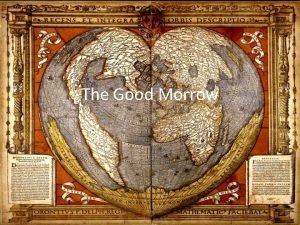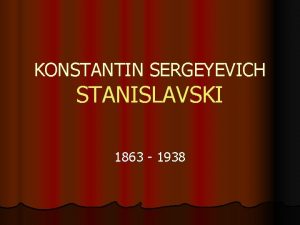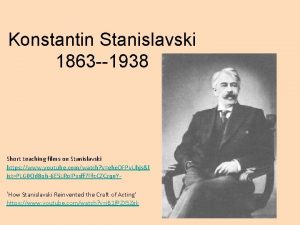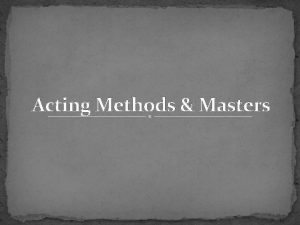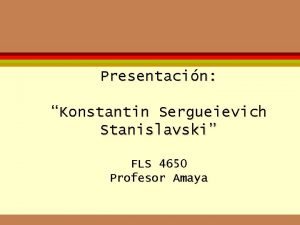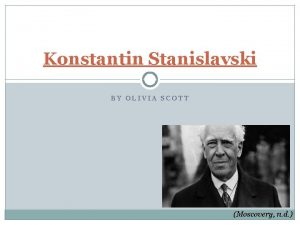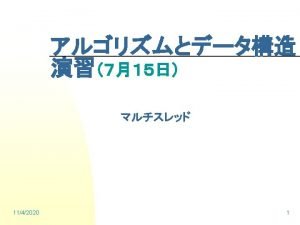Konstantin Stanislavski 1863 1938 Whatever thread one takes























































- Slides: 55

Konstantin Stanislavski 1863 - 1938 “Whatever thread one takes up in the history of twentieth-century drama leads back to Stanislavsky” James Roose-Evans

Beginnings… • He is thought of as the ‘father’ of realistic acting. Although there were other actors and directors working with similar techniques, Stanislavski was the one who organised his ideas into a utilisable ‘system’ • A tour to America in the 1930 s also brought him worldwide recognition • His first experiences in theatre were as a young child in the 1870 s and he worked professionally until his death in 1938 therefore he had a loooonnnngggg career • You need to be familiar with his early experiments in theatre, his failure to connect with drama school, his early professional career and his dozens of productions with the Alexeyev Circle (a family troupe), his self-founded The Society of Art and Literature (his first professional gig) and finally the world famous Moscow Arts Theatre (MAT) • • ‘Stanislavski for beginners’ is a very accessible introduction to Stanislavski It is written like a comic book but is hugely informative and will give you a very good grasp on his life and career • • You really need to dedicate yourself to 2 – 3 hours of reading per week Lets take it gently for now….

Stanislavski for Beginners • Stanislavski for beginners is a very accessible introduction to Stanislavski • It is written like a comic book but is hugely informative and will give you a very good grasp on his life and career • I would like you, as a group, to present Act 1 and Act 2 (the first two chapters) as an improvised drama to the others when they return from School show rehearsals (next Wednesday)

Historical, social and theatrical context of Russia in the late 1800 s • Stanislavsky and the Russian Theatre. mht

Influences - The State of Russian Theatre • Stanislavski’s system came out of his own struggle to improve as an actor. He saw the Theatre as a moral instrument, which could civilise, increase sensitivity and heighten perception. • When Stanislavski started in the Theatre standards were haphazard and actors would inhabit the stage as they sought fit and deliver the lines of the text downstage centre and out front. The style was melodramatic and actors were not artists “An actress would move to the window or the fireplace for no better reason that was what she always did”. Stanislavski felt that “Theatre was controlled by barmen on one hand bureaucrats on the other” (Bendetti) • The role of the director was essentially ignored, the “star” actors of the day would ignore any attempt at direction given and settle for what they knew best. According to Bendetti “Lead actors would simply plant themselves downstage centre, by the prompter’s box, wait to be fed the lines and then deliver them straight to the audience in a ringing voice, giving a fine display of passion” • If Stanislavski was to find the artistic role models that he sought, he would have to look back a generation of ‘artists’ “to the great days of the Maly theatre when artistic standards had been set and discipline imposed by two men of genius, the actor Mikhail Shchepkin and the writer Nikolai Gogol…where the first steps had been taken towards a genuinely Russian style – Realism” (Bendetti)

Influences - The Maly Theatre (meaning Little Theatre) • • Instead, Stanislavski devoted particular attention to the performances of the Maly Theatre, the home of psychological realism in Russia Psychological realism had been developed here by Alexander Pushkin, Nikolai Gogol and Mikhail Shchepkin. In 1823, Pushkin had concluded that what united the diverse classical authors—Shakespeare, Racine —was their common concern for truth of character and situation, understood as credible behaviour in believable circumstances Gogol, meanwhile, campaigned against overblown, effect-seeking acting. In an article of 1846, he advises a modest, dignified mode of comic performance in which the actor seeks to grasp "what is dominant in the role" and considers "the character's main concern, which consumes his life, the constant object of his thought, the 'bee in his bonnet. '"This inner desire forms the "heart of the role, " to which the "tiny quirks and tiny external details" are added as embellishment The Maly soon became known as the House of Shchepkin, the father of Russian realistic acting who, in 1848, promoted the idea of an "actor of feeling. “ This actor would "become the character" and identify with his thoughts and feelings: he would "walk, think, feel, cry, laugh as the author wants him to. “ A copy of Shchepkin's Memoirs of a Serf-Actor, in which the actor describes his struggle to achieve a naturalness of style, was heavily annotated by Stanislavski. Shchepkin's student, Glikeriya Fedotova, was Stanislavski's teacher (she was responsible for instilling the rejection of inspiration as the basis of the actor's art, along with the stress on the importance of training and discipline, and the practice of responsive interaction with other actors that Stanislavski came to call "communication") Shchepkin's legacy included the emphasis on a disciplined, ensemble approach, the importance of extensive rehearsals, and the use of careful observation, self-knowledge, imagination and emotion as the cornerstones of the craft In 1888 Stanislavski established the Society of Art and Literature as an amateur company at the Maly Theatre, where he gained experience in ethics, aesthetics and stagecraft. He gradually took a leading position while acting in such lead roles as Othello and Benedict in Much Ado About Nothing From MLIA “Mikhail Shchepkin, whose tradition still lived in the Moscow Little Theatre in the days of my youth…was a friend of our great writer Gogol and the educator of an entire generation of great and competent artists. He was the first to introduce simplicity and lifelikeness into the Russian Theatre” P 10.

Influences - The Meiningen • • • German court theatre of the late 19 th century whose innovations in staging, scene design, lighting, and period research had an influence on directors such as André Antoine and Stanislavski. “Through its adavnced production tecniques in the naturealist/realist style it was respnsible for influencing aq nmber of theatre companie, including Stanislavski and th Mocsow art Theatre”-Drama and theatre studes. “Stanislavki first saw the company perform in 1980”-Drama and theatre studies Stanislavski was inspired by the unity of production elements; the sense of realism; the artistic integrity and the discipline and commitment of the both actors and director Ludwig Chroengk who directed with an “iron hand”. “The restraint and cold bloodedness of Chroengk were to my taste and I wanted to imitate him”-My Life in Art He was especially impressed with the coherence of the production and the effectiveness of the crowd scenes, something he would later recreate to stunning effect in his own production of The Seagull. “The choreographed movement of extras, which isolated the protagonist in dynamic stage pictures”-Drama and theatre studies Stanislavski realised that if much was to be expected of the actors in terms of application, dedication and discipline, it was important that they should be treated with respect and given decent conditions to work in. He had previously been appalled at the derelict and decrepit theatres and dressing rooms in particular. “Outside of theatre Chroengk’s relations even with the third-rate actors of his company were simple and friendly…But as soon as rehearsal began and Chroenak mounted his usual place he was reborn”.

Influences - Nemirovich Danchenko and the foundation of The MAT • • By 1897 Stanislavski was becoming disenchanted with the life of an amateur parttime actor, but when he was approached by Vladimir Nemirovich-Danchenko, an acting teacher at the Philarmonic School, things began to change. A meeting was soon arranged. It so happened that in 1897 Nemirovich has a particularly talented group of actors, who would make the ideal basis for a new company. Among them was Olga Knipper (later to become Chekhov's wife), and Meyerhold, both of whom were destined to become founding members of the new theatre and Stanislavski's lifelong friends. The first meeting with Nemirovich lasted 18 hours, but by the end they had, in all but detail, laid the foundations for the policy of theatre. They went as far as discussing individuals, and not for the last time, Stanislavski used the phrase when vetoing an actor: "She is a good actress but not for us. . . She does not love art, but herself in art". As Stanislavski records, he was to be predominantly responsible for artistic matters, such as devising the production plans and some directing, and would also continue as an actor. Nemirovich would look after literary matters, such as choosing the repertoire, and would also direct. Benedetti, in his biography, highlights five separate qualities that at this time which concerned Stanislavski: Theatre was to be a moral instrument. Its function was to civilise. It was to increase sensitivity. It should heighten perception. It should ennoble the mind and uplift the spirit.

Influences - Realism and Naturalism • • There is absolutely no doubt on Stanislavski's position on Realism. He made the concepts embodied in it the guiding principles of his life and work and was totally opposed to what he saw as the meaningless experiments of the avant-garde. Though he was noted for groundbreaking productions in new styles, such as The Bluebird (1908), he totally failed to appreciate Gordon Craig's point of view when discussing their production of Hamlet. We need to be clear about the meaning of Realism, however, since there as many definitions as there are contexts and the Moscow Art Theatre was no exception. Since Realism is often seen as synonymous with Naturalism, and since the term Realism is used frequently by Stanislavski, we must make a clear distinction between the two. Naturalism as a movement in literature and drama was associated with the work of the French novelist Emile Zola. In the preface of his novel Thérèse Raquin he clearly explains: "While I was writing Thérèse Raquin I was lost to the world, completely engrossed in my exact and meticulous copying of real life, and my analysis of the human mechanism" Therefore a basic definition of Naturalism would be that it seeks to meticulously re-create every detail of human life This obsession with exposing a "slice of life" was for a time very influential, and before the term was eventually subsumed into Realism there were some noted practitioners. For example, Strindberg applied the same characters in his Miss Julie (1888) and, like Zola, wrote in his introduction an explanation of his intentions: "So I do not believe in "theatrical characters". And these summary judgments that authors pronounce upon people - "He is stupid, he is brutal, he is jealous, he is mean", etc. - ought to be challenged by naturalists, who know how richly complex a human soul is. . . " It was and remains an extremely influential document, calling into question the one-dimensional characters of 19 th century playwriting. It also questions the actor's insistence on facing the audience at all times. However, one of the problems for us as readers is that Strindberg, even when writing this thesis, used the terms Realism and Naturalism as interchangeable.

Influences – Anton Chekhov • “Let us be just as complex and as simple as life itself” Chekhov quoted in Edward Braun 1982 • Chekhov was an instrumental factor in the success of the Moscow Arts Theatre. He was responsible for the values that theatre sought to embody. • He made Stan realise that theatre is to replicate life itself “to present his characters without moralising” (Cooper and Mac. Key) • His writing was heavily dependant on subtext and inner emotion which is a crucial focus of theatre today • “The script ceases to be an artform based on verbal organisation, like a poem or an novel, and becomes the pretext and context for an activity” Bendetti Pg 47 • “Stanislavsky’s success in creating the Mise-en-scene lay in his ability to turn the nuances of Chekhov’s script into very specific directions for the actors” – Bella Merlin • “Stanislavsky was clearly intrigued by the imitation of real life as his Seagull production illustrates. However, he was so insistent on naturalistic detail that Chekhov’s initial thrill with the production plan was completely wiped out. He grew incensed at the pedantic ‘truth’ that Stanislavsky demanded of the actors” – Bella Merlin • “But theatre is art!. . . You forget, you don’t have a fourth wall” – Chekhov quoted in Bella Merlin

• The ‘super-objective’ is a intrinsic component in Stanislavsky’s ‘system’. Consideration of units and objectives was essential when dealing with such a complex, multi layered text • In ‘An Actor Prepares’, Tortsov begins by referring to Chekhov and shows that Chekhov felt Stanislavsky didn’t really understand what his plays were about. Stanislavsky defines it - “the inner essence, the all embracing goal, the objective of all objectives, the concentration of the entire score of the role, of its major and minor units” – Bella Merlin • Stanislavsky discusses how he didn’t always understand Chekhov’s plays, indeed Chekhov was unhappy with his interpretation of The Cherry Orchard. Stan perceived it as a Tragedy, Chekhov wanted a comedy “Apparently they were not all wallowing in their depression but were longing for gaiety and laughter” – Stanislavsky (‘The Director and the Stage’ – Edward Braun) • Nonetheless, regardless of their disagreements over presentation and style, “All of Chekov’s subsequent work was produced by the company”… “became the standard by which the ensemble work of the company was judged” Cooper and Mackey

Influences – Jacques Dalcroze • • • Émile Jaques-Dalcroze (July 6, 1865 – July 1, 1950) was a Swiss composer, musician and music educator who developed eurhythmics, a method of learning and experiencing music through movement. Emile Jaques-Dalcroze was no stranger to theatre. As a young man he worked as a touring actor and he briefly trained at the Comedie-Francaise in Paris The element that made eurhythmics an "indispensable" part of actor training was the training in rhythm. Rhythmic training helps the actor control the body and move in concert with other actors. Dalcroze wrote, "As concerns the solo actor, rhythmic training should not lead him to think out his own motricity, but simply allow him to attune it to that of the others. " Dalcroze called the system ‘Eurhythmics’ and by 1910, he opened a studio where some of the most famous artists could see his experiments. He began to develop a system that sought to achieve “harmony of body and spirit through a coordination of physical movement and sound movement, musical and spatial elements” [Cooper & Mackay] The Dalcroze Method involves teaching musical concepts through movement. A variety of movement analogues is used for musical concepts, to develop an integrated and natural feel for musical expression. Turning the body into a well-tuned musical instrument, Dalcroze felt, was the best path for generating a solid, vibrant musical foundation. The Dalcroze Method consists of three equally-important elements: eurhythmics, solfège, and improvisation (musical not dramatic)]. Together, according to Dalcroze, these elements comprise the essential musicianship training of a complete musician. In an ideal approach, elements from each subject coalesce, resulting in an approach to teaching rooted in creativity and movement. On a demonstration tour to Russia in January of 1912, Dalcroze in contact with the actors of the Moscow Art Theatre, the most influential theatre in the twentieth century. (The M. A. T. was responsible for popularizing the full-length plays of Anton Chekhov and was the home of the seminal acting teacher Constantin Stanislavski. ) Dalcroze gave a presentation at the state theatre in St. Petersburg, the home of the influential young director, Vsevolod Meyerhold, the man who Stanislavski entrusted his studio to. As a result of the Russian tour, eurhythmics became part of the actor training at the Moscow Art Theatre's First Studio in 1912. Stanislavski turned to Dalcroze after Isadora Duncan had no system that could be easily expressed. Dalcroze’s work was becoming known throughout Europe. Stanislavski favoured his work and from it he devised such ideas such as tempo rhythm in movement. “Wherever there is life, there is action; Wherever action, movement, where movement, tempo; where there is tempo there is movement. ” [Building a Character]

Influences – Isadora Duncan • • • Stanislavski met Isadora Duncan in 1908, when she was dancing in Moscow, and began discussions with her ‘systems’ of movement. It soon became clear that she had no system that could be easily expressed, so Stanislavski turned to Jacques-Dalcroze, whose work was becoming known throughout Europe (Cooper and Mackay – pg 249) This led him to use Tempo-Rhythm in Movement. “when we saw the scenery made of black velvet and the entire portal of the stage turned into a gloomy, sarcophagal awful and airless distance we seem to sense the presence of death and the grave on stage. (this is of the production ‘The Life of Man’). ” “Isadora Duncan, who happened to be in theatre at the time cried out in terror, “mon dieu, c’est une maladie!” (that’s bad), and she was right. ” (MLIA – pg 491) Stanislavski considered her opinion on set design. “I see that all these truths were merely separate elements of art which can fulfil the purposes of creativeness no more that the separate elements of air can serve man for reason. ” (MLIA – pg 492) “Meets Isadora Duncan. Is fired with enthusiasm for her dance. ” (Cooper and Mackay) It was Isadora Duncan who first related movement to emotion… to evolve it’s own forms when given an emotional impetus. ” (James Roose Evans – pg 92)

Othello 1896 • • Stanislavski directed and acted in Othello in 1896 and again in the late 1920 s. He was passionate about the play, it was the only Shakespearian tragedy he had a leading part in producing, and he did so twice. His three books on acting all use Othello as an example. Stanislavski visited Venice before producing the play to gather ideas for set, costume and props design. “In one of the summer restaurants of Paris I met a handsome Arab in his national costume…with the help of the waiter we made the designs of the costume. I learned several bodily poses which seemed to me to be characteristic” Detailed character study from direct observation “Every aspect of the play was focused on the one objective: that of creating an overwhelming psychological realism” (Cooper and Mackey) A critic of the time (Marov) stated of Stanislavski’s performance “This is magnificent…how passion, little by little, takes possession of the whole being” (Of Stan’s portrayal of Othello the character) Written like a work of fiction, Stanislavski details much of his desired rehearsal process in the work An Actor Prepares. He uses the fictional character of Tortsov the director to highlight how he, as a director, would approach work on the text. In An Actor Prepares Tortsov criticises his ‘lead actor’ for an animalistic characterisation of the Othello “You were tempted by the external appearance of a black man in general…you reached for an external characterisation…that it what always happens when an actor does not have at his disposal a wealth of live material taken from life…” In the original production, all present in the “Senate Scene” wore black masks Realistic sounds were used such as a tower bell, splashing oars and chains

MXAT • • Stanislavski sought to build upon the foundations of the work and ethos of the great 19 th century actor Schepkin, whom he quotes in My Life in Art "Seek your examples in life". In other words the actor had to go no further in his quest for truth than to base his art on his cumulative experience of the world around him, mediated and enhanced by the director's interpretation and the rehearsal process. It took some time to acquire suitable premises and it wasn't until their fifth season that they moved into what became the Moscow Art Theatre. The stage was to be functional, the orchestra pit abolished, and the most up-to-date technical and lighting equipment installed. Above all, the two men sought to bring unity and freshness to all aspects of production and presentation. It was this vital philosophy that distinguished their work from the tired old ideals still so readily evident in the work of their rivals. It was to be a truly coherent company and it was to be based on the ethics and beliefs of the best of the past and present. They sought to achieve the following: • Choose plays from a classical repertoire, but also encourage new writing. • Treat actors with proper respect. They in turn would be expected to respond with total dedication to the new discipline. • Rehearse all plays for an agreed amount of time and mount all productions with new designs and costumes.

Realism and Naturalism • • The term Naturalism applied to these two writers' work and began to imply a concern with the suffering and degradation of the servant and working class and an obsession with love, death and moral decay. Realism had evolved from Naturalism and began to supercede it as the desire for an indiscriminate reproduction of lower class life in all its squalor ceased to fascinate the public. The majority of Stanislavski's plays were peopled by characters who reflected the lives of the bourgeois audience who would watch them (the only notable exception being Gorki's Lower Depths). Realism now involved the selection and distillation of the detailed observation of everyday life - not, as with Naturalism, the life itself. While there is an important discrimination to be made both words were used fairly interchangeably by practitioners at the time, including Stanislavski. However, while Stanislavski desired to work towards the idea of Realism, in practice he was smothering the real in the detail of Naturalism. A poignant example of this was Stanislavski's over-detailed naturalistic set design which he would later fall out with Chekhov over. Stanislavski wanted the highest standard of representation for each new production resulting in a stage picture which left nothing to the imagination. Realism, as a method, stands apart because of its emphasis on the subtext of a play; text was no longer a matter of surface meaning and characters said things with hidden agendas and intentions. It was on the way towards an understanding of this and how it could be communicated with feeling that many aspects of the System were devised.

The three problems Stanislavski was concerned with the three central problems faced by the actor: • Fear/nervousness at being watched by an audience which leads to self consciousness and unnatural behaviour on stage • The difficulty of believing a lie • Keeping a part fresh over a long run

The attribute of a genius actor Stanislavski believed that actors of genius (such as Shchepkin) all possessed the same core attributes • Complete technical control of voice and movement • A high level of concentration • A state of relaxation that comes from feeling at home on the stage • A ‘creative state of mind’ that leads to moments of inspirational and magical theatre

The System • • Stanislavski's 'system' focused on the development of artistic truth onstage by teaching actors to "live the part" during performance. Despite being primarily known in The United States for Realism, Stanislavski developed the system to be applied to all forms of theater, directing and producing melodrama, vaudeville, opera, etc. In order to create an ensemble of actors all working together as an artistic unit, he began organizing a series of studios in which young actors were trained in his system. At the First Studio of MAT, actors were instructed to use their own memories in order to naturally express emotions. Stanislavski soon observed that some of the actors using or abusing Emotional Memory were given to hysteria. Although he never disavowed Emotional Memory as an essential tool in the actor's kit, he began searching for less draining ways of accessing emotion, eventually emphasizing the actor's use of imagination and belief in the given circumstances of the text rather than her/his private and often painful memories. Stanislavski's 'system' is a systematic approach to training actors. This system is at some point different from but not a rejection of what he states earlier in affective memory. At the beginning, Stanislavski proposed that actors study and experience subjective emotions and feelings and manifest them to audiences by physical and vocal means - Theatre language. While his System focused on creating truthful emotions and then embodying these, he later worked on The Method of Physical Actions. This was developed at the Opera Dramatic Studio from the early 30 s, and worked like Emotion Memory in reverse. The focus was on the physical actions inspiring truthful emotion, and involved improvisation and discussion. The focus remained on reaching the subconscious through the conscious.

• Stanislavski survived the Russian Revolution of 1905 and the Russian Revolution of 1917, with Lenin apparently intervening to protect him. In 1918, Stanislavski established the First Studio as a school for young actors and wrote several works: those available in English translation include: An Actor Prepares, Building a Character, Creating a Role, and the autobiography My Life in Art. • Stanislavski always thought of his system as if it were a table of contents for a large book which dealt with all aspects of acting. His final work, now known as The Method of Physical Actions (see Stanislavski's 'system'), is in no way a rejection of his early interest in sense and affective memory. At no time did he ever reject the notion of emotion memory; he simply found other means of accessing emotion, among them the absolute belief in given circumstances; the exercise of the imagination; and the use of physical action. • The main techniques of the 'system' include Units, Objectives, Given Circumstances, the Through Line and Emotional Memory. "Emotional memory" was an idea taken from Ribot, which was originally called "affective memory". Stanislavski felt that the name "emotional memory" was more accurate for the actor • The system came from wanting to create truth and belief and to avoid clichés. • There are two sides to the system, the inner creative state and the external creative state and when they are combined the actor will achieve the overall creative state. The actor must maintain this general creative state in all creative work- in rehearsals and in performance. Remember- it is not a cookbook! The elements of the system are interdependent. The Elements Action. • Everything that happens on stage must have a purpose. On stage you must not act in a generalised way you must always act with a purpose. • Why am I entering the room? Why do I look in the mirror? In Act Three of The Seagull why does Masha suddenly get up and leave the room?

Magic If • What would I do if I were in this situation? This helps to put you in the character's shoes; it acts as a lever lifting us into the world where it is possible to create – the world of imagination. It does not ask you to believe something is real, you simply act as if you were in those circumstances. • What would you do if you were in Masha’s situation in Act 4? Imagine you were playing the part and say how you would react and how you would use this in performance, BUT do not forget the Given Circumstances. Given circumstances. • The factors that an actor must take into account as he or she creates the character. • The facts and events that happen in the play. The time and setting can also affect the way the characters think and behave, and their ways of relating to each other. The actor must be aware of all the elements of the Mise-en –scene. • The Given circumstances for Act 1 of “Three Sisters” – Inside the Prozorov house which is situated outside a large provincial Russian town with a population of 100, 000 and it is close to a river. It is May and it is a sunny Sunday morning just before noon etc. You must always use take the given circumstances into account when using The Magic if. Imagination. • It is not possible for a playwright to supply all the information that actors need to know about characters. Stage directions may say, “ enter Kulygin” but the actor needs to know where he is coming from or going to. The actor has to fill out the Given Circumstances with his imagination. • “ If you say a single word, or do anything on stage mechanically, without knowing who you are, where you have come from, why, what you want, where you are going and what you will do when you get there – you will be acting without imagination, and this part of your time on stage, be it long or short, will not be truthful for you- you will be like a clockwork machine, an automaton. ” Stanislavski.

Concentration of attention. • Stanislavski developed this because sometimes the actor’s attention on stage can be scattered. You can be too aware of the audience. He used the device of Circles of Attention. It gives the actor a focus for their attention. The circles radiate from the centre of attention (the actor) and in increasing circles take in the whole of the stage area. In the smallest circle the actor can create Public solitude, a condition that focuses the actor within him/herself. By increasing the focus the actor can begin to take in further objects and gradually, by concentration, the whole of the stage/imagined world is brought into focus. Relaxation. • Stanislavski believed that physical tension impairs an actor’s work. It can hamper movement and constricts the voice. The actor must be able to monitor him or herself, and remove areas of unnecessary tension. Actors should practice so that they can do this automatically. Relaxation is enhanced if you think of a purpose to your actions. Units and objectives. • The actor must break down a play into smaller sections or “units”. To define a unit, look for where a new action begins-and where it ends. Stanislavski suggests you need to find a title that captures the essence of each unit. For each unit, you should ask yourself: “what happens? ” Define the action and not the subject matter. In every unit, “there is a creative objective”- a goal. You need to be able to define the character's objective in each unit. The objective should always be believable. When Natasha enters in Act 1 you need to decide what her objective is and this would then affect the way in which you acted. • The super objective is an overall goal. All the other objectives become steps leading to the final goal. You can trace a line through the role and Stanislavski called this “through line of action”. When Stanislavski was rehearsing “Three Sisters” he felt that at first it wasn’t coming to life. It seemed gloomy and dull. He then realised what was missing. “ Chekhov’s characters do not wallow in their own sorrow. Just the opposite; they seek joy, laughter, courage. They want to live and not to vegetate…I came to life, and intuitively knew what to do. ” He had discovered the super objective. The three sisters dream of going to Moscow and escaping the triviality of provincial society; the aspiration for a better life is the ultimate goal they all share.

Faith and a sense of truth. • Every moment on stage should be filled with a belief in the truthfulness of the emotion felt and the actions carried out. Stanislavski said “ Truth on the stage is whatever we can believe in sincerely, whether in ourselves, or in the souls of our partners. ” When Chebutykin smashes the clock he must belief in this action and the emotions it stirs. “If you cannot grasp at once the truth of the larger action, then you must divide it into parts, and try to believe even if only in the smallest of them…Perhaps you do not yet realise that, often from just one moment of faith in the authenticity of an action, an actor can immediately begin to feel himself in his part and to believe in the greater truth of the whole play. ” Stanislavski Emotion memory. • Our lives are a rich source of memories, experiences and observations. Stanislavski suggests that the actor selects the “most absorbing memories” of feelings and sensations, and weaves the life of the character from them. He recognised the danger in trying to force feelings too directly. Emotions can be indirectly evoked from use of other areas of the system like physical action. External elements of the production like lights and sound can also act as a stimulus. Relate this to characters in the play and think of stimulus for these emotions.

Communication • In life we always speak with a purpose and we listen. To speak is to act. Actors often do not listen to their partner in a scene. It is different when they actually communicate “ one of them wants to convey his feelings to another, or to convince him of his ideas, and at the same time the other tries to take in those feelings and ideas” The actor must concentrate on maintaining an uninterrupted exchange of thoughts and feelings with other actors. Tempo rhythm • This is everything we do internal and external. • Tempo is the speed of an action. • Rhythm is not only in the changes in speed but also with stress. • The actor may have their own rhythm but be surrounded by actors with other rhythms. It is important that the rhythms are kept distinct. Look for examples of different rhythms in the play. • Stanislavski would set a number of metronomes at different speeds in the rehearsal room in order to help actors find their own internal and then external rhythm

Stanislavski’s Productions at MXAT Stanislavski’s early mise-en-scene (all that is seen on stage) were very detailed and extremely naturalistic. See slides on • The Seagull • Uncle Vanya • The Cherry Orchard • Tsar Fyodor • The Lower Depths However, later in his career he became more experimental and influence by abstract art and symbolism See slides on • The Blue Bird 1908 • Hamlet 1911 -12 • Dea. D SOULS? • TARTUFFE?

Tsar Fyodor Ioannovich 1898 by Aleksei Tolstoi “Stanislavsky is a real artist, he transformed himself into the general so completely that he lived his life down to the smallest detail. The audience didn't need any explanations. . In my opinion that is the direction theatre should take” Lenin (1918)

Production information- Tsar Fyodor • Tsar Fyador Ivanovich opened on the 14 th of October 1898. However the play was written in 1875 but could only now in 1898 be released by the censor for public performance. • Production was a tremendous popular success because of its naturalism however while the critics gave it good reviews Stanislavski was disappointed in the performance, declaring that the actors were imitating his directions rather than truly acting. • The MXAT survived partly thanks to Count Alexei Tolstoys historical drama Tsar Fyador Ivanovich as it was there first performance. • Tsar Fyador had in Victor Simov a naturalistic designer of outstanding talent. • The role of Victor Simov in the revolution of the Arts Theatres style was crucial. In every case he worked on an equal footing with the director from the earliest stages of the production. He did much to advance the conception of the stage setting as a lived in space, following the Meiningen companies example by employing diagonals and varied levels

Directorial Approaches Employed • • • 1. 2. 3. Stanislavski took a similar approach with Tsar Fyador which he had took with Othello but in addition it was given no fewer than 74 rehearsals. When Simov and Stanislavski started working on Tsar Fyador, they began by steeping themselves in all available documentaries and pictorial sources; next they organised expeditions to the ancient cities of Rostov, Nizhny, Novgorod and Kazan in order to absorb the atmosphere of the 16 th C Russia, to make sketches, to collect authentic furs, gowns and assorted bric a brac. In rehearsals for Tsar Fyador, Stanislavski asked each actor to prepare answers for the following questions; Who am I ? How old am I ? My profession? Members of my family? Where do I live in Moscow? (You must be able to draw the plan of your apartment and the furniture in the rooms. ) How did I spend yesterday ?

The Seagull 1898 Uncle Vanya 1899 by Anton Chekhov (Partially based on a powerpoint by Liubov Oves of the Moscow Arts Theatre)

Ground plans for the Seagull before Simov (designer) after Simov

The Seagull • • • During the late Russian summer of 1898 Stanislavski spent a month and a half alone in a tower in the Ukraine devising a mise-en-scene for Chekhov’s ‘The Seagull’. The members of the Moscow Arts Theatre were in a barn in Pushkin, putting together a repertory for their critical first season. Weeks later, as he was finishing, the company returned to Moscow to rehearse at the Hunt Club and to occupy the dilapidated Hermitage Theatre. Between August 12 and September 20, the director sat in isolation at his desk and struggled to decipher the puzzle that was Chekhov’s difficult and unusual play, to work out what it meant and how he could convey that meaning in a theatrical production. Stanislavsky’s partner, Vladimir Nemirovich-Danchenko had taken a strong initiative with this particular play. Early in 1898, trying to compose his inaugural repertory, he had badgered Chekov with letters pleading for the rights to ‘The Seagull’.

The Seagull - Great Directors at Work (David Richard Jones) • • • “Konstantin Stanislavski and The Seagull” in Great Directors At Work by David Richard Jones (1986) Spent a month and a half alone during the summer of 1898 creating a miseen-scene for The Seagull and trying to unlock the complexities of the play and how these might be communicated in production. “diagrams…. 500 notes on everything from love to barking dogs…of course, a mise-en-scene is no more an evening at theatre than a ground is an office building…. but even as a step in a sequence, the making of his mise was an artistic event with its own integrity, an imaginative act that raised issues for analysis and comment” The production was initially chosen by Danchenko rather than Stan, badgering Chekhov for the rights and presenting a four hour lecture to introduce the company to the first two acts, sending Stan to the Ukraine to work on the mise-en-scene. Danchenko worked Stan’s mise-en-scene into the rehearsal process as Stan’s notes arrived in the post. Of 26 rehearsals, Danchenko directed 15 and so to an extent Stan had created a production for Danchenko. Such collaboration was unusual in the late 19 th century theatre world but normal practice for Danchenko and Stan at MXAT.

The Seagull - Great Directors at Work (David Richard Jones) • • The Seagull’s first audiences must have found some of the dialogue pointless and the action drab, “the inertia of personal and social lives” commented Danchenko. “In short, the meaning of The Seagull was about as difficult to grasp in 1898 as that of Waiting For Godot was in the mid 1950’s” The conflict of the play centred around an existentialist crisis. Even Stan’s initial comments were negative “monotonous…boresome…character’s half human…lacked stageworthy scenes or images…are you sure it can be performed at all? …. I just can’t make head or tail of it” Danchenko though was a literary man and could easily identify the play’s merits. Stanislavski was ill prepared to deal with such a text. Ten years of producing amateur theatre, a further decade producing with the Society of Art and Literature, eight of those years directing following Fedotov’s departure. But his work (and successes) had centred around Vaudeville and Melodrama. “He was known for stunning production techniques and extraordinary abilities as a colorist, fantasist, historicist, melodramatist…reputation as an elderly teacher is so widespread…we often forget he was a classical showman”

The Seagull - Great Directors at Work (David Richard Jones) • “In his early directing…repeatedly used crowd scenes, panoramas, special effects, and startling images to cover poor character development and weak acting. But The Seagull is nothing but acting” It was also “a revolutionary dramatic structure by any standards” • However, after receiving positive feedback from the company and Danchenko, Stanislavski began to build in confidence and continue to do so throughout productions over the next decade. “Stanislavski was already on the path to becoming Chekhov’s director and the leading modern spokesman for theatrical realism” • What is a mise-en-scene? Combination between staging and setting – the visual aspects of a production. “The Seagull miseen-scene is full of stage designs, descriptions of settings, diagrams of movement and groupings, plus hundreds of notes on blocking, picturization and visual rhythms” During the mise-en-scene stage the director is alone with the play and searching for her/his image of it, her/his interpretation.

The Seagull - Great Directors at Work (David Richard Jones) • • DETAILS OF THE SEAGULL’S MISE-EN-SCENE – “Sorin’s estate was crowded, deep and dimly lit…benches, stumps for sitting…a garden seat built around a tree trunk…hothouses, more trees and shrubs…another path…bushes and sunflowers…when the stage’s curtain opened midway through act 1, the audience saw beyond it a lake and trees, moonlit and beautiful… a dense maze… a faint lantern atop a post” All these visual images ran in conjunction with a detailed sound plot of “frogs and dogs and birds and bells and singing drunks and distant thunder” Stanislavski allowed the audience to absorb this atmosphere by beginning with a ten second pause before character’s entered. When they did they spoke the dialogue and “continued to meander across the cluttered stage” “The lighting of cigarettes, the cracking of nuts, Medvyedeno swinging the small club he carried, starting and stopping, entering and exiting, walking around obstructions – all these Stanislavski added. To such a short scene he gave busy hands and feet. . he added a huge amount of business throughout the mise” In terms of the rhythm of the dialogue, he phrased the material “parsing it into units of meaning and then sculpting those units around physical movements” “Stanislavski’s emphasis on the visual and physical oversimplified certain minor characters… seemed surprisingly uninterested in Sorin…his life’s unsatisfactory qualities… his unfulfilled aspirations…Stanislavski ignored these considerations and saw the character as a man holding props (blanket, cigarette, cane, hat)”

Production Information – Uncle Vanya • • In 1899, Anton Chekhov found himself in an awkward situation. The previous year, the newly founded Moscow Art Theatre (MXAT) had staged a tremendously successful production Chekhov's The Seagull. After its triumph, MXAT expected to receive the rights to the Moscow premiere of Uncle Vanya. Chekhov, however, had already promised the play to the state-supported Maly Theatre. After MXAT’s Success with Chekhov's Seagull, Nemirovich quickly requested the rights to Uncle Vanya. The playwright knew he had finally found a truly talented company to stage his works, but he was bound by his former commitment to the Maly Theatre. If not for an attempted bowdlerization, MXAT would probably have lost the premiere of Vanya and its growing reputation as Chekhov's principal interpreter. A committee at the Maly objected to the scene in which Vanya fires a gun at the Professor, criticizing the gesture as an insult to intellectuals. The Maly demanded cuts. Chekhov refused and promptly delivered the play to the Moscow Art Theatre Stanislavski directed and played Astrov. “Uncle Vanya” was the third major play from Chekhov. The play was completed in 1897, and performed in 1899. It was subtitled “Scenes from Country-Life” and there is strong emphasis on such. Stanislavki’s over attention to detail evokes the general mood of rural Torpor but undercut the inner drama of the play Stanislavski spent the summer of 1899 creating his promptbook for Vanya, envisioning himself in the title role. Nemirovich, however, didn't see his tall, handsome co-director as the avuncular type, and he soon persuaded Stanislavsky to play the doctor, Astrov. Chekhov, who had loathed Stanislavsky's performance as Trigorin in The Seagull, wanted to remove Stanislavski from the cast altogether. In a letter to the actress Olga Knipper, who played Yelena, Chekhov offered the following assessment: "When he directs then he's an artist but when he acts he's just a rich young merchant who wants to dabble in art. " The playwright finally accepted MXAT's casting, but expressed a concern that the puritanical Stanislavsky wouldn't exude Astrov's sexual energy. "Inject some testosterone into him, " Chekhov quipped to Nemirovich as the company began rehearsals. . Though critics and public responses were mixed, “Uncle Vanya” far outstripped “The Seagull” in popularity.

Directorial Approaches Employed - Vanya • • • Meyerhold notes that Vladimir Nemirovich Danchenko is domineering of Stanislavski in rehearsal. At first everything ran smoothly, but tension quickly mounted between the co-directors. Nemirovich, who saw himself as Chekhov's representative in rehearsals, was always more focused on the text. Stanislavsky, in contrast, was more concerned with the visual, physical, and aural life of the production. As opening night approached, Nemirovich wrote to Stanislavsky: "We are both aware that it is awkward to disagree during rehearsals. It is embarrassing in front of the actors, don't you think? . . . I feel obliged to ask you for a few concessions. Obliged by my conscience as a writer. . . I don't want a handkerchief on your head to keep off mosquitoes, it's a detail I simply cannot take. And I can tell you for certain that Chekhov won't like it. During the rehearsals and premiere, Chekhov was stuck in Yalta, where the doctors had exiled him in an effort to spare his tubercular lungs. He didn't see MXAT's Uncle Vanya until the spring of 1900, when the Theatre went on tour to Sevastopol and Yalta. Despite the positive notices Stanislavsky had received, Chekhov remained skeptical about his portrayal of Astrov. Before the tour, he warned Nemirovich, "Remembering [Stanislavsky's] acting for me is so depressing I can't shake it off, and in no way can believe that he is good in Uncle Vanya although everyone writes to me with one voice that he is nonetheless good and even very good. " Chekhov was pleased with MXAT's work when he finally saw the production. He even complimented Stanislavsky and offered him a suggestion for Astrov's departure at the end of the play: "[Astrov] whistles. Listen, he whistles! Uncle Vanya is crying, but Astrov whistles!" Stanislavsky got no further explanation from Chekhov, but he immediately integrated the new stage direction into his performance, interpreting it, or perhaps misinterpreting it, as Astrov's loss of faith in humanity. By the time MXAT reached Chekhov in Yalta, the troupe was imploring the playwright for a new script. Debilitated by a tubercular infection that would take his life in four years and distracted by his romance with Olga Knipper, Chekhov didn't have a completed play to open MXAT's next season. But that fall, he brought the troupe Three Sisters - a play tailored for the MXAT company.

The Lower Depths by Maxim Gorky 1902 Jean Benedetti on Gorky. mht

Production Information • • In 1902 the Moscow Art Theater staged the first production of Maxim Gorky's play The Lower Depths, which is about a group of people living in a flophouse in Czarist Russia The Lower Depths (literally: 'At the bottom') is perhaps Maxim Gorky's bestknown play. It was written during the winter of 1901 and the spring of 1902. Subtitled "Scenes from Russian Life, " it depicted a group of members of the Russian underclass in a shelter near the Volga. Produced by the Moscow Arts Theatre on December 18, 1902, Konstantin Stanislavski directed and starred. It became his first major success, and a hallmark of Russian socialist realism. • When it first appeared, The Lower Depths was criticized for its pessimism and ambiguous ethical message. The presentation of the lower classes was viewed as overly dark and unredemptive, and Gorky was clearly more interested in creating memorable characters than in advancing a formal plot. However, in this respect, the play is generally regarded as a masterwork. • The theme of harsh truth versus the comforting lie pervades the play from start to finish, as most of the characters choose to deceive themselves from the bleak reality of their condition.

The Cherry Orchard by Anton Chekhov 1904

Production Information – The Cherry Orchard • Again, on the 17 th of January 1904 the MXAT were given responsibility to produce the world premiere of one of Anton Chekov’s plays, this time entitled “The Cherry Orchard” • This production (Like “The Lower Depths” and “Julius Caesar” also produced that season) were produced in the Meiningen Style with heavy emphasis on external naturalism

‘The Cherry Orchard’ • • The final draft was despatched in October 1903. Chekhov came to Moscow in December and spent almost every day at the plays’ final six week's rehearsals. Chekhov and Stanislavski were far from harmonious. Chekhov was unable to persuade Stanislavski in his view of the Cherry Orchard as “a comedy, at times almost a farce. ” Stanislavski argued that it is “a tragedy, no matter what solution you may have found in the second act for a better life. ” 3 months later Chekhov was seen to be still complaining to Olga Knipper that the play was portrayed as a drama in it’s promotional posters.

• Stanislavski handled the play with uncertainty; accommodating Chekhov’s comedy perspective and missing the point completely. One striking alteration was Stanislavski proposed to set Act 4 in the same nursery that Act 1 was set in. • Stanislavski and Simov were responsible for the “oppressive emptiness” which the text prescribes. • In Act 3, Stanislavski doesn’t fill the stage with extras as he once would have, and conveys Chekhov’s mood. His prompt book reads: • “A completely abortive ball. Very few guests. Despite all their efforts, they’ve only managed to drag along the station manager and the post office clerk…Silence prevails the whole evening, so you think they’d come along to a funeral. ” • Yet again, the fascination of the new technology of naturalism had proven too strong for Stanislavski. Chekhov said to someone in Stanislavski’s hearing “I shall write a new play and it will begin with a character saying ‘how wonderfully quiet it is! There are no birds to be heard, no dogs, no cuckoos, no owls, no nightingales, no clocks, no harness bells, and not a single cricket. ’” • Stanislavski records this in his memories and it seems that he has little regard for Chekhov’s theatrical instinct.

Vladimir Egorov’s designs for The Blue Bird by Maeterlinck Directed by Stanislavski in 1908

Vladimir Egorov’s designs for The Blue Bird by Maeterlinck Directed by Stanislavski in 1908

Vladimir Egorov’s designs for The Blue Bird by Maeterlinck Directed by Stanislavski in 1908

Vladimir Egorov’s designs for The Blue Bird by Maeterlinck Directed by Stanislavski in 1908

Production Information- The Blue Bird • • While founded and grounded in naturalism, the Moscow Art Theater continued to expand experiment with each production. Maintaining their style of quieter performances, theater evolved in the opposite direction of realism. They worked with conventional plays, both playing with and following the rules of conventional theater at the time. This phase was characterized by works grounded in symbolism, such as The Blue Bird, a play by Maurice Maerlinck. In this play, two siblings named Mytyl and Tytyl search for the “blue bird of happiness” aided by a fairy named Berylune. For a company steadfast in maintaining utter realism in details such as set and costume, it's very surprising that The Blue Bird's concept was even considered for production. However, theater's thoroughness continued with this project; The Blue Bird was rehearsed 150 times before it was opened to the public. Another notable characteristic during this phase was the minimal set design, Stanislavski directed a number of symbolist plays between 1904 and 1908 but only the Blue Bird was considered a success Stanislavski was determined to demonstrate the MXAT’s ability to produce avantgarde work that was neither naturalistic nor realistic Maurice Maeterlinck's The Blue Bird was first produced by Stanislavsky at the Moscow Art Theatre in 1908. Written as a play for children, it's a fantastical allegory laden with Maeterlinck's love of symbolism, as a poor girl and boy fall asleep on Christmas Eve and dream of pursuing happiness in the form of a blue bird.

Directorial Approaches Employed – The Blue Bird • 1908 Following disagreement between Stanislavski and Danchenko as to the future work of the art theatre, a solution is reached and Stanislavski is to mount one “experimental” production a year. And others by arrangement. • Stanislavski's growing interest in abstracted styles led to MAT's production of a series of symbolist plays. Stanislavki meets Isadora Duncan and is fired with enthusiasm for her dance and how it might relate to Maeterlinck’s “Bluebird”. • There were 150 rehearsals of The Blue Bird. • Begins to apply new methodologies to rehearsals such as use of extended improvisations and discovering the “objective”.

A Month In The Country 1909 Production Information • • • The MXAT recreated some scenes from “A Month in the Country” in Kiev Palace Park. The park closely resembled the setting of the second act. During this experiment, Stanislavski stopped, unable to continue his “false and theatrical pose” When the play was revealed to the public it was recognised as one of Stanislavski’s most sensitive productions. The play is a conversation piece set on a nineteenth centaury country estate. It was very different from his earlier work as his mise-en-scene was largely static and devoid of external affairs. It is classified as part of the “stormy petrel” of the Revolution The audience’s attention was on the characterisation and emotions conveyed through facial expression and gesture rather than design as in his earlier productions. However, setting was still important - and was designed by Dobuzhinsky – they were stylised evocations of the period, a confined symmetrical space with the actors mainly in a semi-circle.

Directorial Approaches Employed • • While attempting to put these discoveries (the “Magic If”) into practice Stan encountered considerable scepticism within the company. Eventually he isolated a small group of actors and devoted four months exclusively to experiment which led to the studying of “A Month in the Country” He failed to win over the majority of the company to his new ideas which were not yet clearly formatted and often dogged by his own dogmatism. For years later he was an outsider in his own theatre company and on uneasy terms with Nemirovich Danchenko who assumed greater responsibility as a director. Stanislavski began to direct “A Month in the Country” in December 1909. He discarded elaborate preparations and collaborating with the actors was considered paramount. The text was broken down into “units”, but the cast found the rehearsals difficult.

Edward Gordon Craig Constantin Stanislavski and Edward Gordon Craig—two of the 20 th century's most influential theatre practitioners— collaborated on the Moscow Art Theatre's seminal production of 1911– 12 Craig conceived of their production as a symbolist monodrama, in which every aspect of production would be subjugated to the play's protagonist: the play would present a dream -like vision as seen through Hamlet's eyes.

Hamlet by William Shakespeare 1911 Craig favoured stylized abstraction, while Stanislavski wanted to explore psychological motivations. Stanislavski hoped to use the production to prove that his recentlydeveloped 'system' for creating internallyjustified, realistic acting could meet the formal demands of a classic play

Hamlet by William Shakespeare The most famous aspect of the production is Craig's use of a single, plain set that varied from scene to scene by means of large, abstract screens that altered the size and shape of the acting area. The different arrangements of the screens for each scene were used to provide a spatial representation of the characters' states of mind or to underline a dramaturgical progression across a sequence of scenes, as visual elements were retained or transformed.

“Create your own method. Don't depend slavishly on mine. Make up something that will work for you! But keep breaking traditions, I beg you ” Konstantin Stanislavski
 Konstantin stanislavski born
Konstantin stanislavski born Facts about stanislavski
Facts about stanislavski Konstantin stanislavski born
Konstantin stanislavski born July 1-4 1863
July 1-4 1863 Second industrial revolution
Second industrial revolution Manet, olympia, 1863
Manet, olympia, 1863 Where did impressionism originated
Where did impressionism originated Edouard manet olympia 1863
Edouard manet olympia 1863 Edouard manet olympia 1863
Edouard manet olympia 1863 Edouard manet olympia 1863
Edouard manet olympia 1863 Jeff wall morning cleaning
Jeff wall morning cleaning Olympia, 1863
Olympia, 1863 Constitucion de 1863
Constitucion de 1863 Hjälper sedan 1863
Hjälper sedan 1863 Nov 19 1863
Nov 19 1863 During the free banking era between 1837 and 1863
During the free banking era between 1837 and 1863 Homestead act of 1863
Homestead act of 1863 Stanislavski's method
Stanislavski's method Revolucion rusa caracteristicas
Revolucion rusa caracteristicas Communion stanislavski
Communion stanislavski Stanislavski metoda
Stanislavski metoda Stanislavski method
Stanislavski method Inner monologue stanislavski
Inner monologue stanislavski Stanislavski subtext
Stanislavski subtext Artaud techniques bbc bitesize
Artaud techniques bbc bitesize Constantine stanislavski
Constantine stanislavski Constantine stanislavski
Constantine stanislavski Stanislavski method
Stanislavski method New deal political cartoons
New deal political cartoons German aggression map
German aggression map 1982-1938
1982-1938 1982-1938
1982-1938 Rebecca 1938
Rebecca 1938 Madrecita mía de gabriela mistral
Madrecita mía de gabriela mistral Merton strain theory 1938
Merton strain theory 1938 Kovani novac kraljevine jugoslavije 1938 vrednost
Kovani novac kraljevine jugoslavije 1938 vrednost 1938 time man of the year
1938 time man of the year 5 agosto 1938
5 agosto 1938 Romania in anul 1938
Romania in anul 1938 1938 stroomstoten
1938 stroomstoten Mga bansa sa unang digmaang pandaigdig
Mga bansa sa unang digmaang pandaigdig Parnasslased
Parnasslased Morris 1938 pragmatics
Morris 1938 pragmatics Hva er landsmål og riksmål
Hva er landsmål og riksmål 1900 oldsmobile
1900 oldsmobile 1938 presidential series stamps
1938 presidential series stamps Finally brothers whatever is true
Finally brothers whatever is true Gas pressure
Gas pressure Do gases exert pressure on whatever surrounds them
Do gases exert pressure on whatever surrounds them Whatever you do in word or deed
Whatever you do in word or deed Whatever you tolerate will dominate
Whatever you tolerate will dominate Oasis free to be whatever
Oasis free to be whatever Whatever system
Whatever system Whether the weather poem
Whether the weather poem Andor insert
Andor insert Whatever dies was not mixed equally
Whatever dies was not mixed equally

